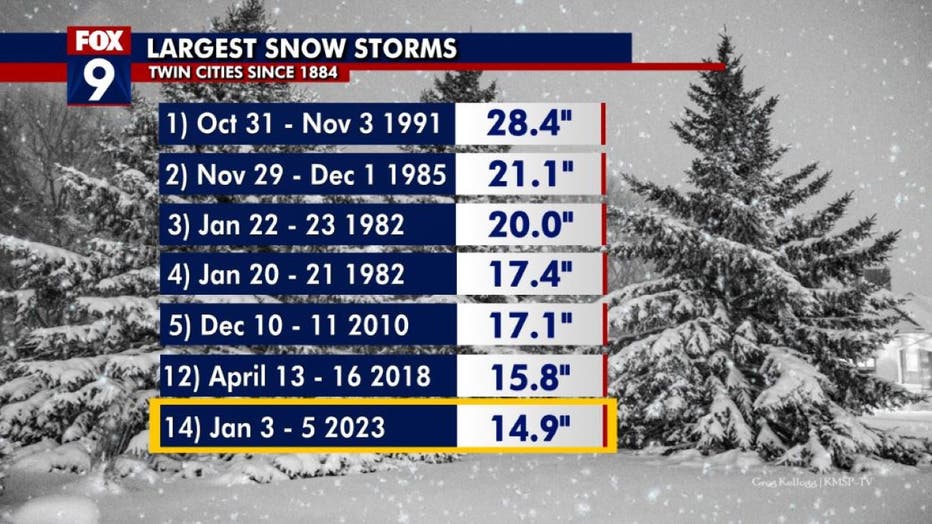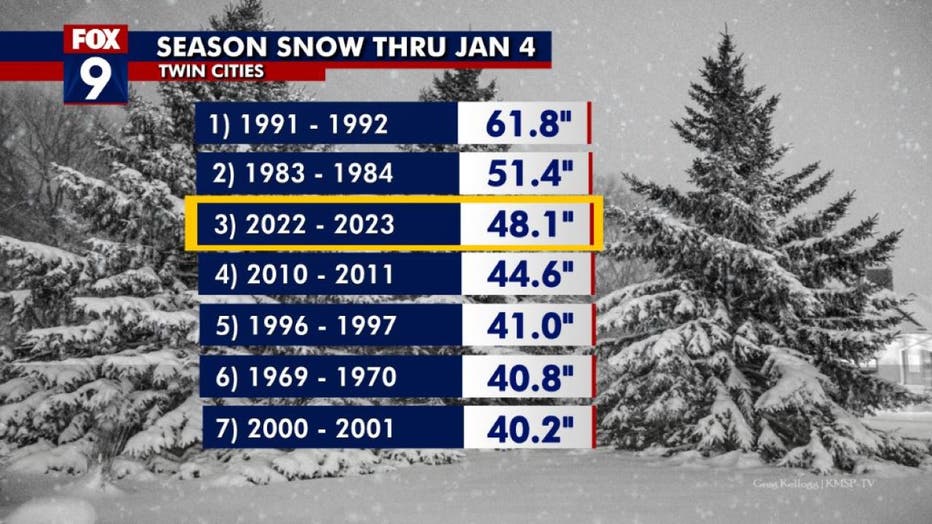Minnesota weather: Huge January snowstorm among the largest on record for Twin Cities

Minnesota weather: 13th largest snowstorm on record
Another large storm rolls across Minnesota and Wisconsin this week dropping more than 6 inches of snow on much of the area, but many spots in the Twin Cities received around or over a foot. MSP Airport received just shy of 15 inches over the three calendar days, which ranks it as one of the largest snowstorms for the metro dating back to 1884.
MINNEAPOLIS (FOX 9) - Another large storm rolled across Minnesota and Wisconsin this week, dropping more than 6 inches of snow on much of the area, but many spots in the Twin Cities received around or over a foot. Minneapolis-St. Paul International Airport received just shy of 15 inches over the three calendar days, which ranks it as one of the largest snowstorms for the metro dating back to 1884.
To put this storm into perspective, it's very similar to some now "famous" Minnesota storms. No, I'm not talking about the Halloween blizzard, but two far more recent storms.

The largest Minnesota snow storms. (FOX 9)
The more infamous storm from an outsider's perspective would be when the Metrodome roof collapsed because of roughly 17 inches of heavy wet snow. That was just over 12 years ago now, from December 2010. Even more recent, but likely only locals at the time will remember, is from April 2018 when more than 15 inches of snow decorated the metro mid-month — along with 50 mph winds. That was the largest snowstorm so late in the season and just the second blizzard in the Twin Cities since the year 2000.

The snow the Twin Cities has received so far this season. (FOX 9)
This storm was pretty close to both of those overall, but happening in January is very unusual. Now the fourth-largest snowstorm on record in the month of January and the largest since 1982. This is just the continuation of a very active season so far with well above-average snowfall for November, December, and now January. We have tallied just over 4 feet so far which is the third most to this point in the year.

Where this season ranks on total snow accumulation. (FOX 9)
So, what does this mean for the rest of the year? Well, nothing really. Just like everything else, snow is very pattern based and often comes in bunches. Just because we have seen a very active season so far doesn't mean that will continue.
There have been many years that started active, but then the snow essentially shut off after January with hardly a flake falling for the rest of the season. The opposite has also of course occurred — we're far more familiar with that recently, with many recent years starting off slow and then really picking up in February with heavy snow continuing into April.
We'll have to wait and see, but at least all of our moisture will help with all of your snow activities moving forward and the drought as it starts to melt in a few weeks.

When there's enough snow on your roof to build a snowman, you should make other safety checks
The winterstorm in Minnesota over the past few days has dropped plenty of snow across the metro, which could led to some dangerous situations for residents.

